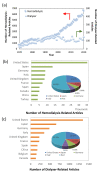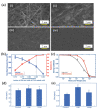A Review of Commercial Developments and Recent Laboratory Research of Dialyzers and Membranes for Hemodialysis Application
- PMID: 34677533
- PMCID: PMC8540739
- DOI: 10.3390/membranes11100767
A Review of Commercial Developments and Recent Laboratory Research of Dialyzers and Membranes for Hemodialysis Application
Abstract
Dialyzers have been commercially used for hemodialysis application since the 1950s, but progress in improving their efficiencies has never stopped over the decades. This article aims to provide an up-to-date review on the commercial developments and recent laboratory research of dialyzers for hemodialysis application and to discuss the technical aspects of dialyzer development, including hollow fiber membrane materials, dialyzer design, sterilization processes and flow simulation. The technical challenges of dialyzers are also highlighted in this review, which discusses the research areas that need to be prioritized to further improve the properties of dialyzers, such as flux, biocompatibility, flow distribution and urea clearance rate. We hope this review article can provide insights to researchers in developing/designing an ideal dialyzer that can bring the best hemodialysis treatment outcomes to kidney disease patients.
Keywords: blood; commercial dialyzer; dialysis; dialyzer design; hemodialysis; membrane.
Conflict of interest statement
The authors declare no conflict of interest.
Figures













Similar articles
-
National Kidney Foundation report on dialyzer reuse. Task Force on Reuse of Dialyzers, Council on Dialysis, National Kidney Foundation.Am J Kidney Dis. 1997 Dec;30(6):859-71. doi: 10.1016/s0272-6386(97)90096-2. Am J Kidney Dis. 1997. PMID: 9398135 Review.
-
A comparison of dual dialyzers in parallel and series to improve urea clearance in large hemodialysis patients.Am J Kidney Dis. 2003 May;41(5):1008-15. doi: 10.1016/s0272-6386(03)00198-7. Am J Kidney Dis. 2003. PMID: 12722035 Clinical Trial.
-
Dialyzer reuse-Part I: Historical perspective.Semin Dial. 2006 Jan-Feb;19(1):41-53. doi: 10.1111/j.1525-139X.2006.00118.x. Semin Dial. 2006. PMID: 16423181
-
Increased binding of beta-2-microglobulin to blood cells in dialysis patients treated with high-flux dialyzers compared with low-flux membranes contributed to reduced beta-2-microglobulin concentrations. Results of a cross-over study.Blood Purif. 2007;25(5-6):432-40. doi: 10.1159/000110069. Epub 2007 Oct 23. Blood Purif. 2007. PMID: 17957097 Clinical Trial.
-
Dialyzer reuse--part II: advantages and disadvantages.Semin Dial. 2006 May-Jun;19(3):217-26. doi: 10.1111/j.1525-139X.2006.00158.x. Semin Dial. 2006. PMID: 16689973 Review.
Cited by
-
Artificial Kidney Engineering: The Development of Dialysis Membranes for Blood Purification.Membranes (Basel). 2022 Feb 2;12(2):177. doi: 10.3390/membranes12020177. Membranes (Basel). 2022. PMID: 35207097 Free PMC article. Review.
-
Co-occurrence of Idiopathic Hypereosinophilic Syndrome in End-Stage Renal Disease Patients Undergoing Maintenance Hemodialysis.Cureus. 2024 Feb 7;16(2):e53758. doi: 10.7759/cureus.53758. eCollection 2024 Feb. Cureus. 2024. PMID: 38465088 Free PMC article.
-
Polyethersulfone Polymer for Biomedical Applications and Biotechnology.Int J Mol Sci. 2024 Apr 11;25(8):4233. doi: 10.3390/ijms25084233. Int J Mol Sci. 2024. PMID: 38673817 Free PMC article. Review.
-
3D porous structure imaging of membranes for medical devices using scanning probe microscopy and electron microscopy: from membrane science points of view.J Artif Organs. 2024 Jun;27(2):83-90. doi: 10.1007/s10047-023-01431-x. Epub 2024 Feb 5. J Artif Organs. 2024. PMID: 38311666 Review.
-
Adsorption- and Displacement-Based Approaches for the Removal of Protein-Bound Uremic Toxins.Toxins (Basel). 2023 Jan 28;15(2):110. doi: 10.3390/toxins15020110. Toxins (Basel). 2023. PMID: 36828424 Free PMC article. Review.
References
-
- Nitta K., Goto S., Masakane I., Hanafusa N., Taniguchi M., Hasegawa T., Nakai S., Wada A., Hamano T., Hoshino J., et al. Annual dialysis data report for 2018, JSDT Renal Data Registry: Survey methods, facility data, incidence, prevalence, and mortality. Ren. Replace. Ther. 2020;6:1–18. doi: 10.1186/s41100-020-00286-9. - DOI
-
- Bikbov B., Purcell C.A., Levey A.S., Smith M., Abdoli A., Abebe M., Adebayo O.M., Afarideh M., Agarwal S.K., Agudelo-Botero M., et al. Global, regional, and national burden of chronic kidney disease, 1990–2017: A systematic analysis for the Global Burden of Disease Study 2017. Lancet. 2020;395:709–733. doi: 10.1016/S0140-6736(20)30045-3. - DOI - PMC - PubMed
-
- Stenvinkel P., Fouque D., Wanner C. Life/2020-The future of kidney disease. Nephrol. Dial. Transplant. 2020;35:II1–II3. doi: 10.1093/ndt/gfaa028. - DOI
-
- Gautham A., Muhammed J.M., Manavalan M., Najeb M.A. Hemodialysis membranes: Past, present and future trends. Int. Res. J. Pharm. 2013;4:16–19. doi: 10.7897/2230-8407.04505. - DOI
Publication types
Grants and funding
LinkOut - more resources
Full Text Sources
Other Literature Sources

